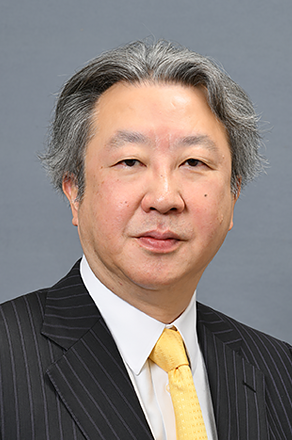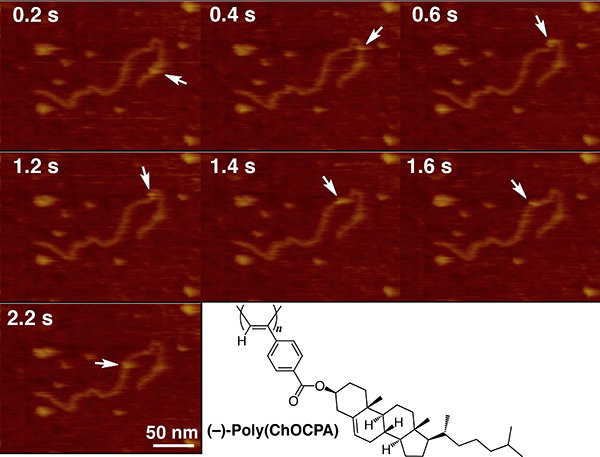
Direct Observation of Single Molecule of a Polymer Molecular Machine Driven by Thermal Fluctuations
Laboratory on Nano-Polymer Chemistry
Associate Professor:SHINOHARA Ken-ichi
E-mail:
[Research areas]
Polymer Chemistry, Artificial-Life Function
[Keywords]
Nanomachine, Polymer Synthesis, AFM Video
Skills and background we are looking for in prospective students
Basic knowledge of organic chemistry and polymer chemistry is necessary for research on functional polymer synthesis. Also, in single molecule imaging research to analyze the structure and dynamics of single polymer chain, understanding of the mechanism of microscope equipment is required.
What you can expect to learn in this laboratory
The objective of our laboratory is to create novel nanomachine such as a molecular motor by a chiral helical π-conjugated polymer in an organic media at room temperature. The members of this laboratory learn basic knowledge and technique of organic/polymer synthesis, single-molecule imaging, computer simulation (all-atom MD), and design of molecular machines.
【Job category of graduates】
Chemical companies, Electronics companies, Food-related companies, Public officials (teachers)
Research outline

Scheme 1. Synthetic Route of a Chiral Helical Polymer

Fig. 1. Single Molecular Unidirectional Processive
Movement along a Helical Polymer Chain in a Non-aqueous Media
Single-Molecule Imaging of a Polymer
Direct observation of a polymer chain deepens the understanding about its structure and function. The study of single polymer chains was made possible after the scanning probe microscope (SPM) and the total internal reflection fluorescent microscope (TIRFM) had been developed. Our group succeeded in the direct observation of the long-chain branch (LCB) structure in a low density polyethylene (LDPE), and the structural dynamics of a polymer chain in a functionalized styrene-butadiene rubber (SBR) and an ethylene-propylene (EP) rubber measured by a fast-scanning atomic force microscope (FS-AFM). Single-molecule imaging of a macromolecular motion in a chiral helical polymer was achieved by the FS-AFM, and the diffusion coefficient of each part of the polymer chain was measured. On the other hand, the photonic function of the light emission from a rigid-rod conjugated polymer was measured using TIRFM at room temperature. The light-emission from a single polymer chain as it slowly and dynamically changes over a cycle lasting a few seconds has been successfully detected using TIRFM with a built-in spectroscope.
A Polymer Molecular Motor
If a molecule can move unideirectionally using thermal fluctuation, a molecular motor having the function of substance transport and morphological change is created. In our recent study, molecular walking along a rail of a synthetic helical polymer (Scheme 1) was discovered by AFM video imaging. This walk was unidirectional processive movement in an organic solvent at room temperature (Fig.1).
This result is a breakthrough as the first step in order to create an artificial life-function as a synthetic molecular motor driven by a thermal fluctuation in non-aqueous media.
Key publications
- K. Shinohara, S. Yasuda, G. Kato, M. Fujita, H. Shigekawa: Direct observation of the chiral quaternary structure in a π-conjugated polymer at room temperature, J. Am. Chem. Soc. 123, 3619-3620 (2001); Editors’ Choice, Science 292, 15 (2001).
- K. Shinohara, Y. Makida, T. Oohashi, and R. Hori: Single-Molecule Unidirectional Processive Movement along a Helical Polymer Chain in Non-aqueous Medium, Langmuir, 38 (40), 12173-12178 (2022).
- K. Cheng, K. Shinohara, O. Notoya, M. Teraguchi, T. Kaneko, T. Aoki Synthesis and Direct Observation of Molecules of 2D Polymers: With High Molecular Weights, Large Areas, Small Micropores, Solubility, Membrane Forming Ability, and High Oxygen Permselectivity, Small, 202308050 (2023).
Equipment
Fast-Scanning Atomic Force Microscope (FS-AFM), Scanning Tunneling Microscope (STM), Total Internal Reflection Fluorescence Microscope (TIRFM), NMR, Super Computer System for all-atom MD Simulation of a Polymer Chain in Solvent, Analytical System of Single-Molecular Motion of a Polymer
Teaching policy
In the SHINOHARA laboratory, we instruct students to conduct research themes as their own, rather than passively studying. Specifically, the supervisor will actively communicate with students, voluntarily perform experiments according to the student's abilities, and develop the ability to find and solve the scientific problems themselves. By repeating these processes, students are able to answer important questions such as what is scientific research, which in turn leads to awareness as future excellent researchers and engineers.
[Website] URL:https://www.jaist.ac.jp/ms/labs/shinohara/